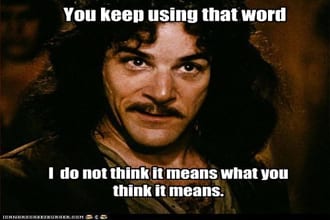News

You Keep Using That Word…
 One of my biggest pet peeves when it comes to writing is grammatical errors. There’s a saying that English is the hardest language to learn and that’s entirely true, with our ever changing definitions and homonyms. It can be confusing and it’s an easy mistake to make when you’re writing. However, making these faux pas do nothing but detract from your piece and are best avoided and carefully edited out. Here are the top 5 grammatical errors made when writing.
One of my biggest pet peeves when it comes to writing is grammatical errors. There’s a saying that English is the hardest language to learn and that’s entirely true, with our ever changing definitions and homonyms. It can be confusing and it’s an easy mistake to make when you’re writing. However, making these faux pas do nothing but detract from your piece and are best avoided and carefully edited out. Here are the top 5 grammatical errors made when writing.
There vs. Their vs. They’re
These are some the most common misused words I see from day to day text messages to articles online.
There – Refers to a place. Example: Let’s go there!
Their – Shows ownership for two or more people. Example: That’s their prize.
They’re – Literally means “they are.” Example: They’re going to the mall.
Here vs. Hear
Here – Designates a place. Example: Come here.
Hear – Refers to your listening with your ear. Example: Do you hear me?
Your vs. You’re
This is another big one that is usually overlooked.
Your – Shows ownership of something. Example: That’s your pony.
You’re – Literally means “you are.” Example: You’re kidding, right?
To vs. Two vs. Too
To – Expresses direction. Example: I want to go to the zoo.
Two – The number 2 spelled out. Example: It takes two, baby!
Too – In addition to something. Example: I love that, too!
Write vs. Right
Write – To pen something. Example: Please, write this down.
Right – Opposite of “left.” Example: Make a right at the light.
Peek vs. Peak
Peek – To glance at. Example: Go peek around the corner.
Peak – The very top of something. Example: We climbed to the mountain’s peak.
We’re vs. Were vs. Where
We’re – Literally means “we are.” Example: We’re going to the store.
Were – Plural past tense. Example: We were going to the store.
Where – References a location. Example: Where are you going?
Who’s vs. Whose
This is one situation where I always have to make sure I’m using the correct form because it’s so easy to forget. We are used to an apostrophe “s” indicating ownership, but in the case of “who’s” that’s not the case. Instead, you use the same pattern you would for “he’s” and “she’s.”
Who’s – Literally means “who is.” Example: Who’s going to the market?
Whose – Shows ownership. Example: Whose shirt is this?
The easiest way to ensure that you’ve use the correct word is to edit, edit, edit and read the sentence out loud. 90% of the time I can correct my grammatical errors this way. For the other 10%, there’s always Google!